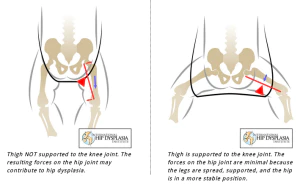Tips to choose the right baby carrier for you and your baby
There is so much choice and options when it comes to baby carrier. Here are some top tips from a physiotherapy expert to help guide you :
1# The comfort of the mum. Test the carrier by yourself first to see what suits your comfort and needs.
Hips:
Choose from those where the thigh bones are supported until the knee crest and knee rests higher than the hips to maintain a good position for the hip joint even when the baby is relaxed (sleeping).

Spine:
The baby’s spine is C shaped, the curves are developing with the gross motor development, so it’s important that the spine is supported in that position. In the outward facing carriers, the baby's spine position depends on the body structure of the person who is wearing the carrier. Facing outwards, the weight is concentrated in the front, which might be uncomfortable and less ergonomic.
Head:
Because the baby’s head is relatively big and heavy it is necessary to support it until they develop the proper head control. With the newborn, make sure the airways are always clear, take extra care if there is any respiratory problem. Chin and nose should be clear of any fabric and the baby's face should be visible for you.


Most of the carriers are for a little older baby, but if you wish to start carrying your newborn check out the wrap type carriers. Those are for the first 3 months.
I used the elastic wrap carrier, which I really loved, it was extremely comfortable however putting it on was a bit tricky. My tip is to master the wrapping with a doll in advance. The wrap itself is ergonomic for your baby since it supports the head and back properly and makes a good alignment for the baby's hip. It is relaxing for the baby since there is a close contact (even skin contact), he/she can hear the heartbeat and smell the mum and the continuous rocking lets them sleep.

I did a few hikes with her in the Alps in this carrier.

When the baby is getting a bit older, he/she might get curious about the world around and wants to have a better view. In this case, using the carrier on the hip or on the back is a better option than facing outwards. But this is not recommended before 6 months and having proper head control and sitting stability.

Depending on the parents needs and the baby’s personality you might need to carry them even when they are bigger and can walk already. Since we like hiking, taking the toddler on our back was also necessary and for this purpose having a good hiking carrier was a big help.




